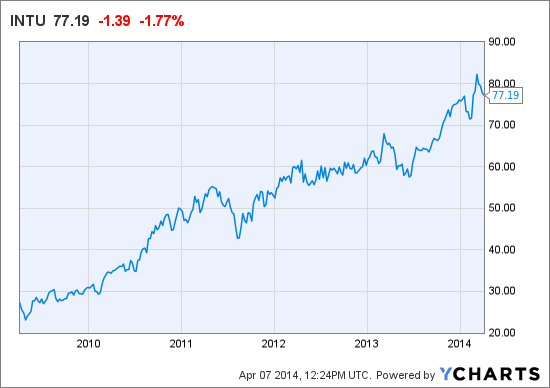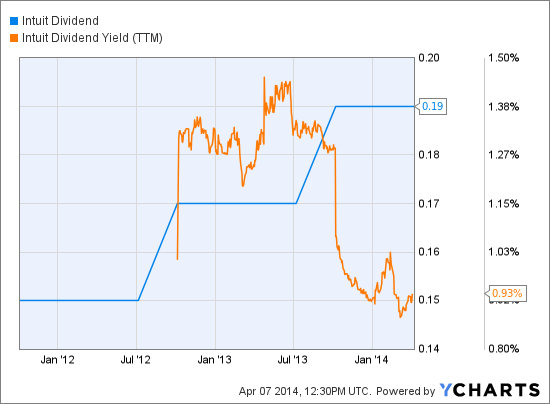Benjamin Clark for Modern Graham writes: Benjamin Graham taught that Intelligent Investors must do a thorough
fundamental analysis of investment opportunities to determine their
intrinsic value and inherent risk. This is best done by utilizing a
systematic approach to analysis that will provide investors with a sense
of how a specific company compares to another company. By using the ModernGraham method
one can review a company's historical accomplishments and determine an
intrinsic value that can be compared across industries. What follows is a
specific look at how Intuit Inc. fares in the ModernGraham valuation
model.

INTU data by YCharts
Defensive Investor - must pass at least 6 of the following 7 tests: Score = 3/7
Balance Sheet - 1/31/2014
Earnings Per Share
Earnings Per Share - ModernGraham
Dividend History

INTU Dividend data by YCharts
From a valuation side of things, the company appears to be fairly valued after growing its EPSmg (normalized earnings) from $1.42 in 2010 to an estimated $2.62 for 2014. This demonstrated level of growth supports the market's implied estimate of 10.46% earnings growth and leads the ModernGraham valuation model to return an estimate of intrinsic value that falls within a margin of safety relative to the price.
The next part of the analysis is up to individual investors, and requires discussion of the company's prospects. What do you think? What value would you put on Intuit Inc.? Where do you see the company going in the future? Is there a company you like better?
You can visit Modern Graham Here.

INTU data by YCharts
Defensive Investor - must pass at least 6 of the following 7 tests: Score = 3/7
- Adequate Size of Enterprise - market capitalization of at least $2 billion - PASS
- Sufficiently Strong Financial Condition - current ratio greater than 2 - FAIL
- Earnings Stability - positive earnings per share for at least 10 straight years - PASS
- Dividend Record - has paid a dividend for at least 10 straight years - FAIL
- Earnings Growth - earnings per share has increased by at least 1/3 over the last 10 years using 3 year averages at beginning and end of period - PASS
- Moderate PEmg ratio - PEmg is less than 20 - FAIL
- Moderate Price to Assets - PB ratio is less than 2.5 or PB x PEmg is less than 50 - FAIL
- Sufficiently Strong Financial Condition, Part 1 - current ratio greater than 1.5 - FAIL
- Sufficiently Strong Financial Condition, Part 2 - Debt to Net Current Assets ratio less than 1.1 - PASS
- Earnings Stability - positive earnings per share for at least 5 years - PASS
- Dividend Record - currently pays a dividend - PASS
- Earnings growth - EPSmg greater than 5 years ago - PASS
Valuation Summary
Key Data:| Recent Price | $77.19 |
| MG Value | $89.40 |
| MG Opinion | Fairly Valued |
| Value Based on 3% Growth | $38.04 |
| Value Based on 0% Growth | $22.30 |
| Market Implied Growth Rate | 10.46% |
| Net Current Asset Value (NCAV) | $0.20 |
| PEmg | 29.42 |
| Current Ratio | 1.42 |
| PB Ratio | 9.79 |
| Current Assets | $2,541,000,000 |
| Current Liabilities | $1,790,000,000 |
| Total Debt | $499,000,000 |
| Total Assets | $4,718,000,000 |
| Intangible Assets | $1,453,000,000 |
| Total Liabilities | $2,483,000,000 |
| Outstanding Shares | 283,510,000 |
| 2014 (estimate) | $3.05 |
| 2013 | $2.72 |
| 2012 | $2.52 |
| 2011 | $2.00 |
| 2010 | $1.66 |
| 2009 | $1.35 |
| 2008 | $1.33 |
| 2007 | $1.25 |
| 2006 | $1.05 |
| 2005 | $1.00 |
| 2004 | $0.79 |
| 2014 (estimate) | $2.62 |
| 2013 | $2.29 |
| 2012 | $1.97 |
| 2011 | $1.64 |
| 2010 | $1.42 |
| 2009 | $1.26 |

INTU Dividend data by YCharts
Conclusion:
Intuit
Inc. is suitable for the Enterprising Investor but not the Defensive
Investor. The company's current ratio is too low, the dividend record
too short, and the PEmg and PB ratios too high for the Defensive
Investor. The Enterprising Investor's only gripe with the company is the
low current ratio, but the overall debt level remains acceptable. As a
result, the Enterprising Investor following the ModernGraham approach
based on Benjamin Graham's methods should feel comfortable proceeding
with further research into the company through a comparison to ModernGraham's valuation of Automatic Data Processing (ADP) and 5 Low PEmg Companies for the Enterprising Investor. From a valuation side of things, the company appears to be fairly valued after growing its EPSmg (normalized earnings) from $1.42 in 2010 to an estimated $2.62 for 2014. This demonstrated level of growth supports the market's implied estimate of 10.46% earnings growth and leads the ModernGraham valuation model to return an estimate of intrinsic value that falls within a margin of safety relative to the price.
The next part of the analysis is up to individual investors, and requires discussion of the company's prospects. What do you think? What value would you put on Intuit Inc.? Where do you see the company going in the future? Is there a company you like better?
You can visit Modern Graham Here.